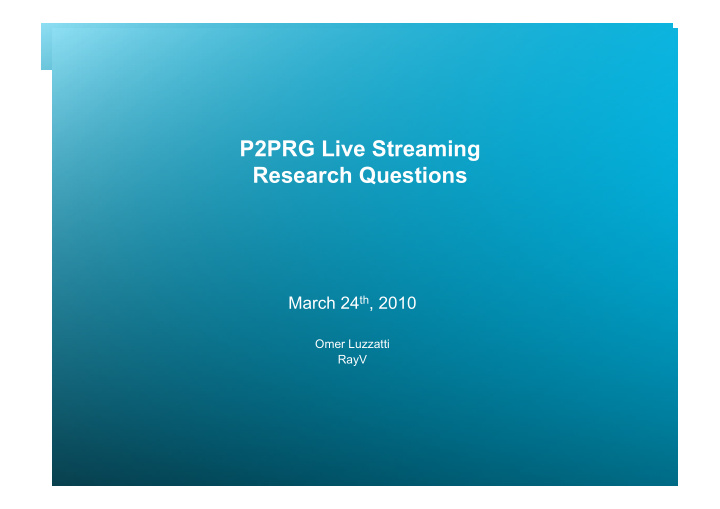



P2PRG Live Streaming Research Questions March 24 th , 2010 Omer Luzzatti RayV
Overview The upstream problem - formulation Grid Topology constraints Push or Pull Static cost and Dynamic cost PET/IDA/Network Coding (the ‘depth’ question)?
RayV in a nutshell Business: White label turn-key solution platform/CDN in a box for the Content owners/Telcos All content is legitimate Working with Telco/MSOs/ISPs Customers: NBA, DirecTV, Blizzard/Activision, Fox sports, American cap, Tennis Channel, Comcast CSN, AB Groupe, ex-pat channels, SMG Usage: On average 500,000 connected peers 100,000 concurrent viewers at peak 8M minutes watched daily P2P facts: 90%-95% cost saving (HW and bandwidth) Building the network cost per concurrent viewer $0.6 Monthly per concurrent $0.5/month (10% of 1Mbps BW cost) Improves quality (due to stream localization)
Customers requirements - Quality Requirements: 500-800Kbps for news/music channels; 800-1.5Mbps for sports; 1.5Mbps to 3Mbps for TVHD experience. Flash cloud issues Adaptive quality (multiple qualities) Rules indicating who can contribute to who. Requirement implication: Since peers can only contribute on average 200Kbps upstream P2P from peers only is limited to 20% of BW needed. Additional sources are needed These additional sources must contribute much more than they consume thus cannot be ‘typical viewers’ if consuming the entire stream. If those sources are ‘CDN nodes’ (hosted by an external CDN as in many ‘hybrid solutions’ or by the P2P provider) the P2P benefits are limited to 20%-30% only. Possible but ‘not desired’ solution: ‘free riding’ on high upstream peers such as universities and institutions. RayV solution: Adding many additional ‘typical’ nodes streaming to each of them minimal data (2 MTUs/sec) and having those re-distribute to many other peers (we call those ‘amplifiers’)
Upstream available
Quality and the upstream problem Requirement: Streaming in at least 1Mbps. Fact: Average upload from typical peer is 200Kbps.
Customers requirements - Quality Viewers only: MR = 4, Us = 4=1M UR = 2 Nv = 2 Amps = 0 Amplifiers: MR = 4, Us=4=1M UR=2 Nv = 3 Amps = 3
Grid structure – Mash vs. Tree Tree Mash 1) Viewer must receive from each branch 1) Not efficient , how much? 2) Branch failure problem 2) Assuming PET/IDA/NC: 3) Tree dynamic creation a) Depth problem 4) Tree management, raising levels b) Delay due to segment size 5) Hidden assumption of ‘balanced tree’ or c) CPU ‘how to balance tree’ and how to solve the d) SVC Layers complexity ‘weaker branch’ problem? (solvable?) 6) Video layers complex things but solvable
Network coding and delay NC P i - is a media packet sized MTU Sz – Segment size Considerations: Segment size adds delay and CPU Each coefficient needs to be sent in the protocol So new size is MTU+2^8*SZ*bits Delay 1) Delay from encoder to viewers must not exceed 8-10 seconds 2) Viewers should watch ‘simultaneously’ with up to 2 sec difference
Delay and hops Requirements: 1) Delay from encoder to viewers must not exceed 8-10 seconds 2) Viewers should watch ‘simultaneously’ with up to 2 sec difference
Peer Dynamics What is the cost of the dynamic behavior? – Peer churn Ratio A/V = 3:1, 1000 Viewers average Viewer life time ~10 minutes No NAT traversal No delay in peer list
Network coding techniques Parameters : Sz - Segment size y - number of primary amps, which receive their equations directly from the satellite. w - 'mixing' factor. Each amp takes equations from w donors and generates a new on. naturally w, increases the needed upload from each amp.
Network coding techniques P i - is a media packet sized MTU Sz – Segment size Considerations: Segment size adds delay Segment size increases CPU Each coefficient needs to be sent in the protocol So new size is MTU+2^8*SZ*bits
Recommend
More recommend